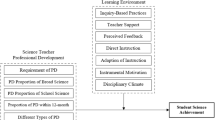Conclusion
The results in this study provide some evidence indicating that there are no major problems confronting students in transition in the schools sampled so far as science is concerned. The majority of students enjoy science at both levels, and, contrary to popular belief, there is no sharp drop off in student attitude as the year wears on.
The maintenance of student satisfaction and positive attitudes seem to be related to the nature of the curriculum materials used and the quality of the interpersonal relationship between teacher and pupils. It would appear that in the open-area high schools involved in this study, the materials used (largely A.S.E.P.) and the identification of the teacher with the school and the students were more conducive to student satisfaction than those in use in the more conventional schools.
That relatively few of the environmental measures used were found to be associated with student outcomes is a little puzzling. One suspects that in part the reasons may lie in the limitations of the instrument and in part in the lack of variance in student attitudes towards science across the transition period. A careful analysis of what actually happens in science lessons and interviews with the participants reveals that whereas most students are satisfied, the reasons for this satisfaction are as rich and varied as the patterns of adaptation utilized by students in transition.
Similar content being viewed by others
References
ALFREY, E.C. Articulation practices and problems between elementary and junior high schools in Nebraska. Ed. D. Thesis, The University of Nebraska Teachers College, 1966.
ANDERSON, G.J. The assessment of learning environments: a manual for the Learning Environment Inventory and the My Class Inventory. Halifax, Canada: Atlantic Institute of Education, 1971.
BLACKBOURN, J.M. Articulation problems in the junior high school. Ph.D. Thesis, East Texas State University, 1966.
BROPHY, J. & GOOD, T. Teacher-child dyadic interaction. Austin, Texas: Research and Development Centre for Teacher Education, 1969.
CATTELL, R.B. & CATTELL, M.D.L.Handbook for the Junior-Senior High School Personality Questionnaire. Champaign, Ill.: Institute for Personality and Ability Testing, 1969.
HARRIS, S. A study of the relationship between the sixth grade students beliefs about junior high school, his concept of self and others, and his socio-economic status. Unpublished doctoral dissertation, Florida State University, 1961.
LAVENBURG, F.M. An analysis of articulation problems of seventh and tenth grade students with implications for administrative action. Ed. D. Thesis, Rutgers University, 1964.
LUTZ, J. The relative effectiveness of a formal versus an informal orientation program for reading sixth grade students concerns about going to junior high school. Ed., D. Thesis, Temple University, 1967.
MURDOCH, W.F. The effect of transfer on the level of childrens' adjustment to school. Unpublished Thesis, University of Aberdeen. Cited in Nisbet, J.D. & Entwistle, N.J.The Transition to Secondary Education. London: University of London Press, 1966.
NISBET, J.D. & ENTWISTLE, N.J.The transition to secondary education. London: University of London Press, 1969.
POWER, C.N. & COTTERELL, J. The transition between primary and secondary school. Report to E.R.D.C., Flinders University, 1979.
STEELE, J., HOUSE, E. & KERINS, T.. An instrument for assessing instructional climate through low-inference student judgment.American Educational Research Journal, 1971, 8, 447–466.
TISHER, R. & POWER, C.N. The effects of classroom activities, pupil perceptions and educational values where self-paced curricula are used. Report of A.A.C.R.D.E. Project, Monash University, 1975.
WINER, B.J.Statistical principles in experimental design. New York: McGraw Hill, 1962.
WINTON, J.L. Articulation problems between elementary and secondary schools affecting Indian and non-Indian students in Cherokee County, Oklahoma. Ed. D. Thesis, University of Arkansas, 1970.
YUTZY, J.A. Articulation problems as perceived by pupils, teachers and administrators in seventh grades of selected junior high schools in the Indiana Public School Study Council. Ed. D. Thesis, Ball State University, 1970.
Rights and permissions
About this article
Cite this article
Power, C. Science achievement and attitudes at primary and secondary interface. Research in Science Education 9, 75–84 (1979). https://doi.org/10.1007/BF02359146
Issue Date:
DOI: https://doi.org/10.1007/BF02359146




